We’re back on the bus for another Hollywood tour of golden age movie star’s homes.

First stop is the home of one of the most popular stars of the 1930s and ‘40s, Don Ameche. Signed to a contract by 20th Century Fox in 1935, Ameche was equally adept at musicals, comedies, and dramas. One of his most popular films, The Story of Alexander Graham Bell released in 1939, led to “Ameche” becoming a slang term for the telephone in that era. He was paired with Fox’s female stars, Alice Faye, Betty Grable, and Carmen Miranda. Ameche also starred in the popular radio comedy, The Bickersons with Frances Langford during the 1940s.
Ameche resided at 4684 White Oak Avenue in a Spanish style 3,000+ square foot house with an orange grove, a pool, tennis court, and five acres for his six children. Before Ameche bought it, W. C. Fields had rented the home. The current owners claim that the ghost of Mr. Fields still resides there. When his film career waned in the late 1940s, Ameche moved to New York and starred in several shows on Broadway including the Cole Porter musical, Silk Stocking. From 1961 until 1965, he hosted the NBC television program, International Showtime.
After a decade out of the limelight, Ameche made a comeback in 1984 when he was cast as a villain in the Eddie Murphy film, Trading Places. He won the Academy Award for Best Supporting Actor in 1985 to a thunderous ovation for his role in Cocoon. Ameche passed away in 1993.
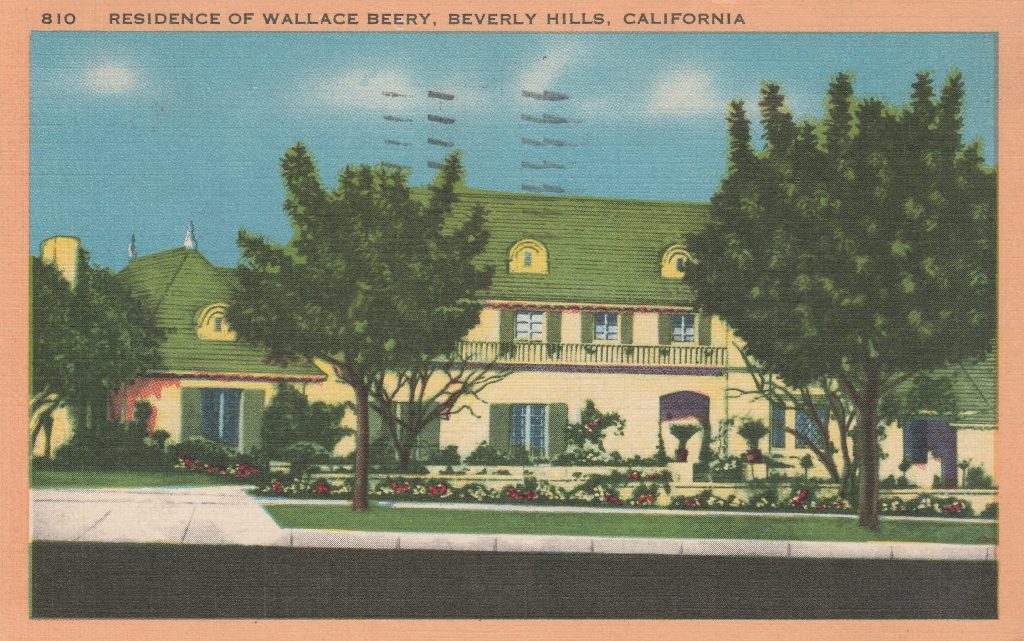
Wallace Beery was a major Hollywood star whose 36-year career spanned the early days of silent movies until his death in 1949 but is little remembered today. He made over 250 films and was equally adept at comedies and playing villains.
Beery won the Academy Award for Best Actor for his role in The Champ in 1931. He tied with Frederic March for his role in Dr. Jekyll and Mr. Hyde. In The Champ, Beery played a former world heavyweight boxing champion who has become a compulsive gambler and alcoholic. He lives with his eight-year-old son Dink (played by Jackie Cooper), who is devoted to his father but frustrated by his irresponsible behavior. The movie’s tearjerker ending resonated at the box office. Many reviewers cited the on-screen chemistry between Cooper and Beery (that was non-existent off screen). A landmark movie, many film critics use The Champ as a yardstick to measure the effectiveness of any film pairing adult and child actors.
Beery also starred in the 1930 movie, The Big House, considered to be the first prison film. His most iconic performance was as Long John Silver in Treasure Island, made in 1934. Two of his biggest hits in the 1930s were Min and Bill and Tugboat Annie, both co-starring Marie Dressler.
Beery’s French Provincial style house was located at 816 North Alpine Drive in Beverly Hills. It was built in 1935 and Beery had at least two other residences in Los Angeles prior to moving to North Alpine Drive. He died of a heart attack in the house in April 1949. His passing was not mourned in Hollywood since his fellow actors considered him difficult to work with and unpleasant on the set.
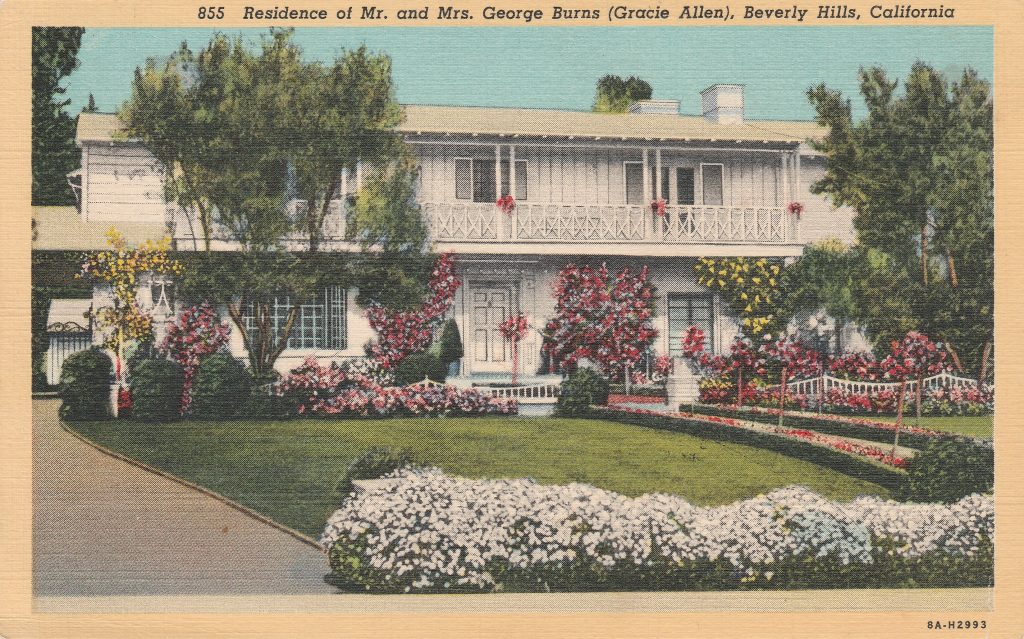
George Burns and Gracie Allen, his wife, began their show business careers separately in vaudeville. They formed an act in 1923 and married in 1926. Their act was simple, George played straight man to Gracie and allowed her to get the laughs and they soon became headliners. In the 1930s they made several successful films in Hollywood and began their radio program. It ran for seventeen years from 1933 until 1950. In 1950, they moved their show to television. One innovation of the situation comedy was George would break the fourth wall and talk directly with the audience. The Burns and Allen Show ran until 1958 when Gracie retired due to a heart ailment. Allen died in 1964 after suffering a heart attack.
After his wife’s death, Burns toured the country performing in theaters and nightclubs and made frequent guest appearances on television but was regarded as a star of a bygone era. In 1975 Burns appeared in his first film in 36 years, The Sunshine Boys, replacing Jack Benny who had withdrawn from its production due to failing health. The comedy earned Burns an Academy Award for Best Supporting Actor at age 80. A hot commodity in Hollywood once more, he starred in several movies including Oh, God!, Going in Style, and 18 Again!
The theme song for Burns and Allen’s radio and television programs was The Love Nest. For their love nest, Burns and Allen bought a lot at 720 N. Maple Drive in Beverly Hills in 1935 and spent $79,000 building a house, pool, and pool house. It was located south of Sunset Boulevard near their vaudeville friends, Jack Benny, and his wife Mary Livingston. After living out of trunks during their vaudeville days, Burns and Allen enjoyed a place to call home and raise their son and daughter. For Burns, the richly decorated house was a long way from his impoverished upbringing on the Lower East Side of Manhattan. Burns resided in the house until his death in 1996 at the age of 100.
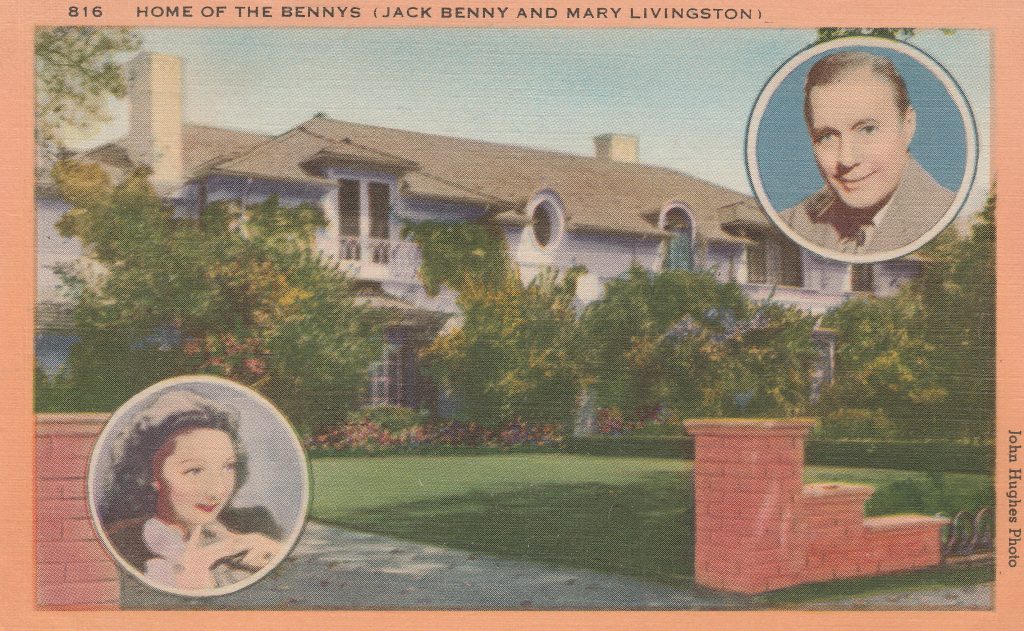
Jack Benny’s show business career spanned vaudeville, radio, movies, and television. Interviewed for a PBS program on the Golden Age of Radio, Benny indicated he had developed his routine in vaudeville and discovered that everyone in America had a cheap uncle or a relative that lied about their age. Another running gag was Benny’s 1916 Maxwell automobile. For his radio and television programs, Benny’s ensemble cast included his wife Mary Livingstone, announcer Don Wilson, bandleader Phil Harris, singer Dennis Day, Mel Blanc, and Eddie “Rochester” Anderson. Benny folded the program after the 1964 – 1965 television season.
In 1938, Benny and his wife bought a newly constructed French style home on a .79 acre plot at 1002 N. Roxbury Drive in Beverly Hills for $250,000. The house had eight bedrooms and seven bathrooms as well as a swimming pool and playhouse for their daughter Joan.
During Hollywood’s Golden Age, Roxbury Drive was considered the most star studded two blocks in Beverly Hills. In the 1950s, Lucille Ball and Desi Arnaz moved in next door to Benny. Jimmy Stewart lived on the other side of Lucy and Desi. Spencer Tracy, Agnes Morehead, Ira and George Gershwin, Jack Haley, Lionel Barrymore, Ginger Rogers, Betty Grable, Oscar Levant, Eddie Cantor, Hedy Lamarr, Thomas Mitchell, Jose Ferrer, Rosemary Clooney, and Polly Bergen were some of Jack’s neighbors during his period.
In 1965, Benny at the urging of his wife sold the house and bought a penthouse apartment in Century City with views of the Pacific Ocean. Benny regretted selling the Roxbury house for the rest of his life. Later he purchased a house in Holmby Hills where he passed away from pancreatic cancer in December 1974 at the age of eighty.
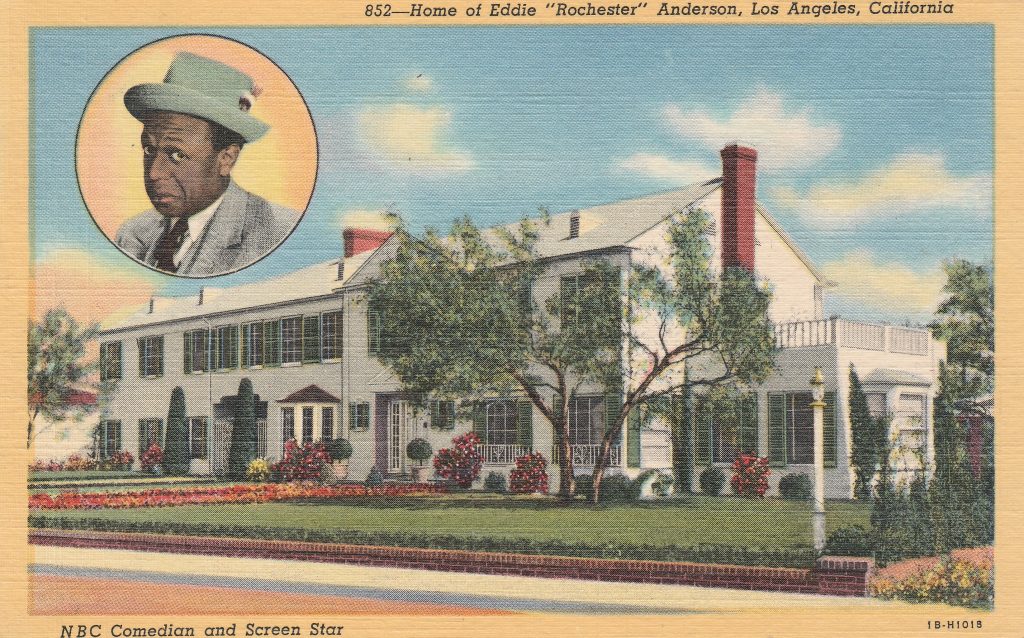
African American actor and comedian, Eddie Anderson, was known for his gravelly voice, the result of ruptured vocal cords he suffered when a teenager. Born in 1905, Anderson began his show business career in vaudeville as a teenager in a song and dance act with his brother, Cornelius. Later he added comedy to their act. Anderson began appearing in films in the 1930s, usually playing a butler, chauffeur, bellhop, or janitor, the only roles open to African American actors.
Anderson first appeared on Jack Benny’s radio program on March 28, 1937, as a railroad redcap who bedevils Benny on a trip from Chicago to Los Angeles. He garnered big laughs and was invited back several weeks later to play the waiter who serves Benny and the other cast members. After a third appearance, Anderson joined the ensemble cast as Rochester Van Jones, Benny’s valet, and butler. He became the first African American with a recurring role on a radio program and achieved immense popularity. In 1950, Anderson moved to television with the rest of the Benny show cast. Rochester received his biggest laughs with his jokes on Benny’s penny pinching. Benny was not afraid to let the other members of his cast get big laughs at his expense.
In 1940, the noted African American architect Paul R. Williams designed and built a large and luxurious Colonial Revival home with a swimming pool, especially for Anderson, in the West Adams neighborhood of Los Angeles. Williams designed homes for other Hollywood stars, including Lucille Ball, Tyrone Power, and Barbara Stanwyck. Many other African American entertainers resided in West Adams since restrictive covenants banned them from owning property in other areas of Los Angeles. Anderson resided there until his death from heart disease in 1977.
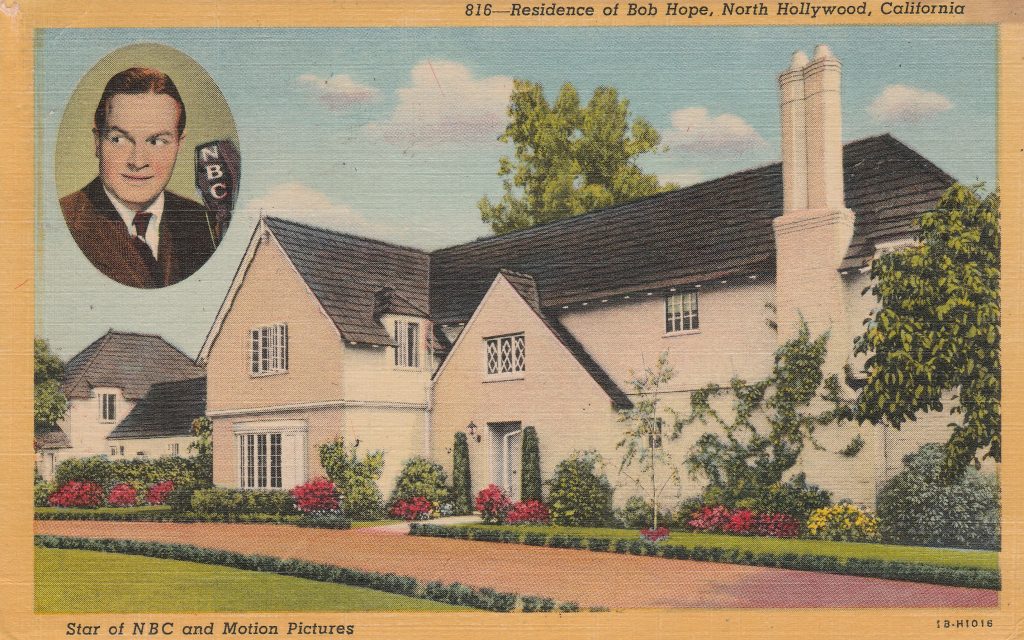
Bob Hope purchased his home at 10346 Moorpark Street in the Toluca Lake section of the San Fernando Valley in 1939. After a long career in vaudeville, Hope had made the transition to Broadway, radio, and movies. The English style country manor was built on 5.16 acres of a former walnut grove. Hope passed away in the house at the age of 100 in 2003. His wife Dolores remained there until her death at the age of 102 in 2011.
In addition to the house, there was a one-hole par three golf hole, both an outdoor and indoor pool, and a pool house, The home was expanded and renovated several times over the decades. A 4,000 square foot building was on the grounds that served as an office for Hope, his writers, and production team. There was a fireproof vault that contained filing cabinets filled with jokes written by Hope’s team of writers over the years for his radio and television programs as well as his tours entertaining American soldiers and sailors. The files were donated to the Library of Congress by Hope’s family.
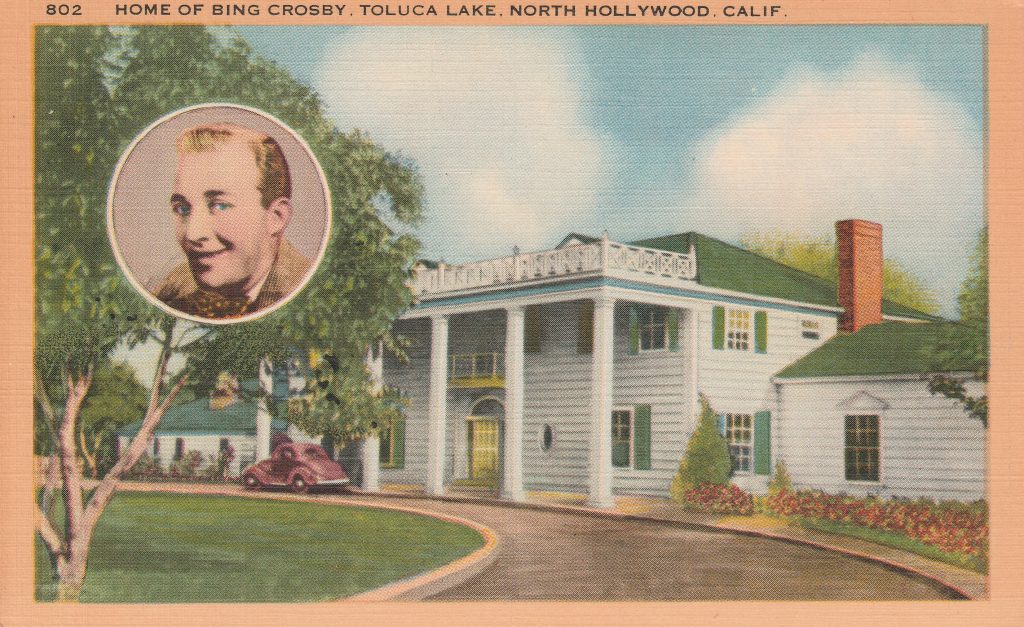
Hope’s neighbor in Toluca Lake at 10500 Camarillo Street was crooner Bing Crosby. Hope and Crosby starred in seven “road” movies starting with The Road to Singapore in 1940 and ending with The Road to Hong Kong in 1962. Crosby starred in a weekly radio program, 15 Minutes, with Bing Crosby in 1931 and ten of his songs dominated the top fifty hits of that year. Crosby is credited with saving the phonograph record industry during the depths of the Depression. In 1936, he became the host of the Kraft Music Hall. Paramount Studios signed him to a contract and over his career he starred in eighty films. Crosby won the Academy Award for Best Actor in 1944 for his role as Father O’Malley in Going My Way.
Crosby and his wife, singer Dixie Lee, moved into the Camarillo Street house in 1936 with their three sons. A fourth son joined the Crosby brood in 1938. The Colonial style house on four acres contained twenty rooms as well as a stable and carriage house. On January 3, 1943, while Dixie was taking down the Christmas tree, a fire broke out that quickly engulfed the house. Lee was able to get their four sons and servants out of the house, but the family’s cocker spaniel Timmy died in the blaze. Crosby was reportedly dining with Fred Astaire at the Brown Derby in Hollywood. Crosby purchased a new home in Holmby Hills and sold the wrecked house since building materials and labor were scarce during World War II. Crosby later resided in the San Francisco Bay area with his second wife, Kathryn Grant.
In the late 1940s, the parents of Mickey Dolenz, a member of the ‘60s band, The Monkees, purchased the home. During the 1970s, Andy Griffith became the owner. Griffith sold it to Jerry Van Dyke, who owned the home during the 1990s.
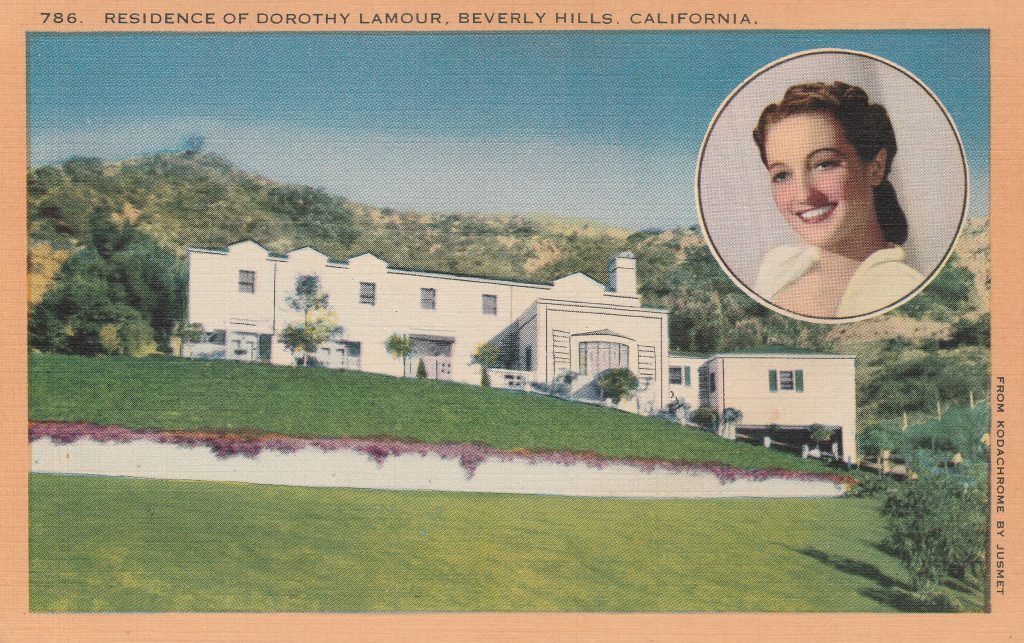
In 1940, Paramount Studios paired Bob Hope and Bing Crosby in a comedy, The Road To Singapore. Singer Dorothy Lamour, known as the Sarong Queen, because of the costumes she wore in movies set in the tropics, was added to the film to serve as the love interest of the two male stars. Lamour, an established star on the Paramount lot, received second billing after Crosby. Bob Hope, not yet a movie star, received third billing.
Dorothy Lamour co-starred with Crosby and Hope in six “road” pictures between 1940 and 1952. In 1962, Hope and Crosby made the seventh and final road picture, The Road to Hong Kong. Hope and Crosby, both aged 59, thought that Lamour at age 48 was too long in the tooth to play their love interest. Joan Collins was cast as the romantic lead although Lamour had an extended cameo in the film.
In the 1930s and ‘40s, Lamour resided in a gated villa at 1375 N. Doheny Drive in Beverly Hills. In the 1950s, Lamour moved to Baltimore with her second husband, advertising executive William Ross Howard III and their two sons.
I have the Eddie “Rochester” Anderson card in my collection.
I found my card at a postcard show last November. The postcard is a testimony to Anderson’s popularity. While researching the article, I found that film censors in the Southern states removed his brief appearances in movies because he was too popular.
Enjoyed your article Immensely. I now have the history with the card. Thanks
Photographers in other cities also sold postcards of local homes because they belonged to prominent families or were representatives of interesting architecture.
At one of the first postcard shows I dragged my husband to, I was looking through some boxes and the seller asked me what I was looking for. I told him that I was looking for a postcard of my house. He laughed, rolled his eyes and turned to help some real customers. I don’t live in Hollywood and I’m not famous but I had the last laugh because I actually found a postcard of my house.
Now I need to see whether I can find my movie star homes cards from this set.! What a lot of excellent info about all those stars. Do you know of the movie star streets in the Kensington area near Normal Heights? I knew of a lady on Lucille Street.
Very interesting and so thoroughly researched. I always enjoy Dan’s articles.